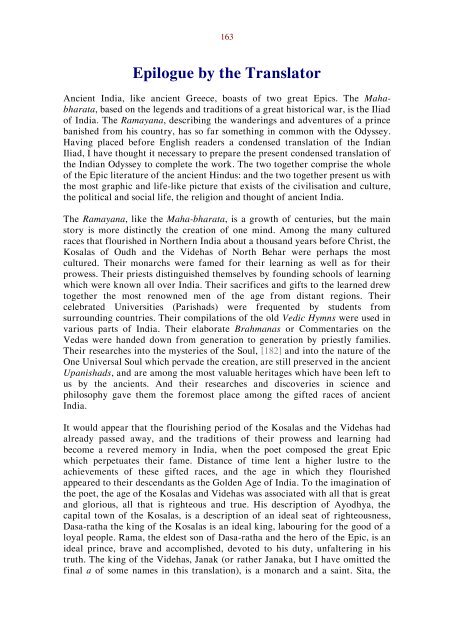Ramayana, Epic of Rama, Prince of India
An Abbreviated Translation of the Indian Classic, the Ramayana by Romesh Chundar Dutt in 2,000 verses
An Abbreviated Translation of the Indian Classic, the Ramayana by Romesh Chundar Dutt in 2,000 verses
Create successful ePaper yourself
Turn your PDF publications into a flip-book with our unique Google optimized e-Paper software.
163<br />
Epilogue by the Translator<br />
Ancient <strong>India</strong>, like ancient Greece, boasts <strong>of</strong> two great <strong>Epic</strong>s. The Mahabharata,<br />
based on the legends and traditions <strong>of</strong> a great historical war, is the Iliad<br />
<strong>of</strong> <strong>India</strong>. The <strong><strong>Rama</strong>yana</strong>, describing the wanderings and adventures <strong>of</strong> a prince<br />
banished from his country, has so far something in common with the Odyssey.<br />
Having placed before English readers a condensed translation <strong>of</strong> the <strong>India</strong>n<br />
Iliad, I have thought it necessary to prepare the present condensed translation <strong>of</strong><br />
the <strong>India</strong>n Odyssey to complete the work. The two together comprise the whole<br />
<strong>of</strong> the <strong>Epic</strong> literature <strong>of</strong> the ancient Hindus: and the two together present us with<br />
the most graphic and life-like picture that exists <strong>of</strong> the civilisation and culture,<br />
the political and social life, the religion and thought <strong>of</strong> ancient <strong>India</strong>.<br />
The <strong><strong>Rama</strong>yana</strong>, like the Maha-bharata, is a growth <strong>of</strong> centuries, but the main<br />
story is more distinctly the creation <strong>of</strong> one mind. Among the many cultured<br />
races that flourished in Northern <strong>India</strong> about a thousand years before Christ, the<br />
Kosalas <strong>of</strong> Oudh and the Videhas <strong>of</strong> North Behar were perhaps the most<br />
cultured. Their monarchs were famed for their learning as well as for their<br />
prowess. Their priests distinguished themselves by founding schools <strong>of</strong> learning<br />
which were known all over <strong>India</strong>. Their sacrifices and gifts to the learned drew<br />
together the most renowned men <strong>of</strong> the age from distant regions. Their<br />
celebrated Universities (Parishads) were frequented by students from<br />
surrounding countries. Their compilations <strong>of</strong> the old Vedic Hymns were used in<br />
various parts <strong>of</strong> <strong>India</strong>. Their elaborate Brahmanas or Commentaries on the<br />
Vedas were handed down from generation to generation by priestly families.<br />
Their researches into the mysteries <strong>of</strong> the Soul, [182] and into the nature <strong>of</strong> the<br />
One Universal Soul which pervade the creation, are still preserved in the ancient<br />
Upanishads, and are among the most valuable heritages which have been left to<br />
us by the ancients. And their researches and discoveries in science and<br />
philosophy gave them the foremost place among the gifted races <strong>of</strong> ancient<br />
<strong>India</strong>.<br />
It would appear that the flourishing period <strong>of</strong> the Kosalas and the Videhas had<br />
already passed away, and the traditions <strong>of</strong> their prowess and learning had<br />
become a revered memory in <strong>India</strong>, when the poet composed the great <strong>Epic</strong><br />
which perpetuates their fame. Distance <strong>of</strong> time lent a higher lustre to the<br />
achievements <strong>of</strong> these gifted races, and the age in which they flourished<br />
appeared to their descendants as the Golden Age <strong>of</strong> <strong>India</strong>. To the imagination <strong>of</strong><br />
the poet, the age <strong>of</strong> the Kosalas and Videhas was associated with all that is great<br />
and glorious, all that is righteous and true. His description <strong>of</strong> Ayodhya, the<br />
capital town <strong>of</strong> the Kosalas, is a description <strong>of</strong> an ideal seat <strong>of</strong> righteousness,<br />
Dasa-ratha the king <strong>of</strong> the Kosalas is an ideal king, labouring for the good <strong>of</strong> a<br />
loyal people. <strong>Rama</strong>, the eldest son <strong>of</strong> Dasa-ratha and the hero <strong>of</strong> the <strong>Epic</strong>, is an<br />
ideal prince, brave and accomplished, devoted to his duty, unfaltering in his<br />
truth. The king <strong>of</strong> the Videhas, Janak (or rather Janaka, but I have omitted the<br />
final a <strong>of</strong> some names in this translation), is a monarch and a saint. Sita, the

















